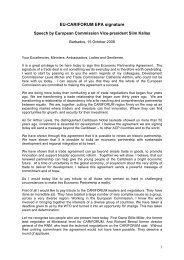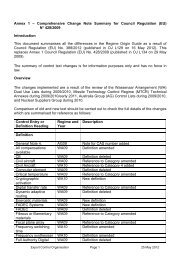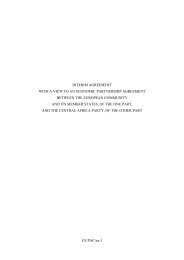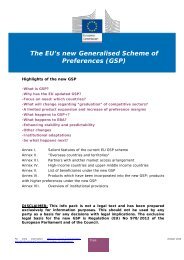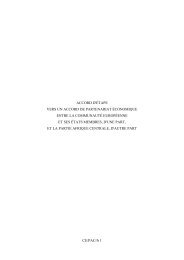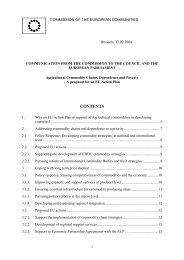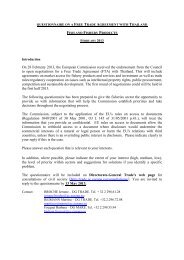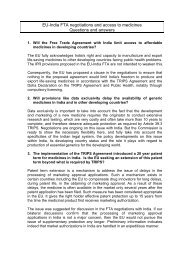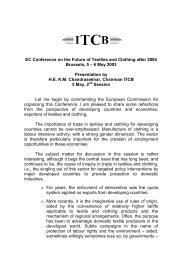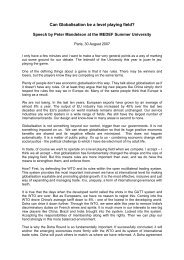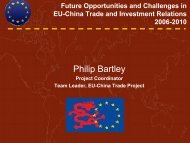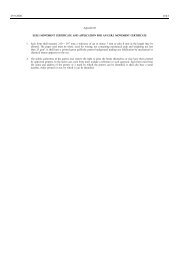Report on the Implementation of the derogation to ... - Trade Websites
Report on the Implementation of the derogation to ... - Trade Websites
Report on the Implementation of the derogation to ... - Trade Websites
Create successful ePaper yourself
Turn your PDF publications into a flip-book with our unique Google optimized e-Paper software.
Final <str<strong>on</strong>g>Report</str<strong>on</strong>g><br />
RoO Derogati<strong>on</strong> under <strong>the</strong> PACP-IEPA<br />
EU loin imports were based <strong>on</strong> a more geographically dispersed supply base in 2010 compared <strong>to</strong><br />
2001. In 2001, <strong>the</strong> <strong>to</strong>p-five 252 provided 92% in volume <strong>of</strong> supply, whereas in 2010 <strong>the</strong> <strong>to</strong>p-five 253<br />
provided <strong>on</strong>ly 75%. This is due <strong>to</strong> growing absolute EU demand and an increased number <strong>of</strong><br />
countries exporting this product. Despite this fluctuati<strong>on</strong>, Ecuador’s relative share declined by <strong>on</strong>ly<br />
1% – from 37% in 2001 <strong>to</strong> 36% in 2010 – but gained a 45% increase in absolute supply. Ecuador is <strong>the</strong><br />
clearly <strong>the</strong> leading supplier <strong>of</strong> tuna loins <strong>to</strong> <strong>the</strong> EU by a large margin. However, processors based<br />
<strong>the</strong>re suffered from a declining availability <strong>of</strong> raw material in 2010. 254<br />
It is also important <strong>to</strong> note <strong>the</strong> growth in EU loin supply from Thailand, from 2% in 2001 <strong>to</strong> 12% in<br />
2010 (Table 6.2). This is despite its exports normally <strong>on</strong>ly being eligible for <strong>the</strong> standard GSP at a<br />
tariff rate <strong>of</strong> 20.5%. Thailand’s increase in relative and absolute market share can be explained by an<br />
EU tariff quota <strong>on</strong> loins where 15,000 mt can be imported annually at <strong>on</strong>ly 6% duty as l<strong>on</strong>g as <strong>the</strong>y<br />
are destined for canning by EU-based processors. 255 The ‘loin quota’ is provided <strong>to</strong> ensure that EUbased<br />
processors receive an adequate supply <strong>of</strong> raw material, but without jeopardising <strong>the</strong><br />
competitiveness <strong>of</strong> <strong>the</strong>se processors through full exposure <strong>to</strong> low-cost imports. 256<br />
Combined, <strong>the</strong> four Latin American GSP+ countries listed in Table 6.2 had a 53% share <strong>of</strong> <strong>the</strong> extra-<br />
EU loins market in 2010, and <strong>the</strong> six African IEPA countries had a 24% market share. This indicates<br />
that <strong>the</strong>se two types <strong>of</strong> preferential trading arrangements are working (i.e. promoting exports <strong>to</strong> <strong>the</strong><br />
EU in this product category).<br />
Excluding PNG and <strong>the</strong> Solom<strong>on</strong> Islands, <strong>the</strong> five Asia-Pacific countries exported a <strong>to</strong>tal volume <strong>of</strong><br />
17,600 mt <strong>of</strong> loins in 2010, a <strong>to</strong>tal 17% share <strong>of</strong> <strong>the</strong> EU market. This indicates two important issues.<br />
First, <strong>the</strong> GSP+ and IEPA countries are unable <strong>to</strong> supply <strong>the</strong> full volume requirement <strong>of</strong> EU-based<br />
processors. Sec<strong>on</strong>d, that <strong>the</strong> ‘loin quota’ is functi<strong>on</strong>ing <strong>to</strong> mainly benefit Thailand and China (Table<br />
6.2).<br />
252 Ecuador, Colombia, Kenya, Côte d’Ivoire and Seychelles.<br />
253 Ecuador, Mauritius, Thailand, Guatemala and El Salvador.<br />
254 Hamilt<strong>on</strong> et al. 2011.<br />
255 The most recent aut<strong>on</strong>omous quota dealing with tuna loins applies from 1 January 2010 <strong>to</strong> 31 December<br />
2012 and is <strong>on</strong>ly available <strong>to</strong> <strong>on</strong>e HS Code for loins (1604 1416) (Council Regulati<strong>on</strong> 1062/2009). These quotas<br />
have been necessary for EU-based processors due <strong>to</strong> insufficient supply <strong>of</strong> loins from third country suppliers<br />
that benefit from duty-free preferences, i.e. ACP, EBA and GSP+ countries; Campling 2008b.<br />
256 Damanaki 2011.<br />
Linpico s.a.r.l. Page 127




